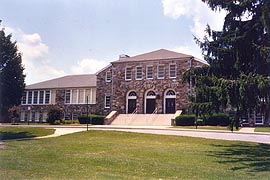![[photo, Paul Laurence Dunbar Middle School, 500 North Caroline St., Baltimore, Maryland]](/msa/mdmanual/36loc/bcity/images/1198-1-2717.jpg) In Maryland, public education is a responsibility shared by State, county and Baltimore City government. The State Board of Education sets educational standards, certifies teachers, partially funds school construction and instruction, and monitors school performance. The Board also oversees the State Department of Education. County boards of education often set additional requirements, develop new programs, and provide substantial local funding. Local, State and federal funds combined to provide $9.5 billion for Maryland public schools in the 2007-08 school year. The average cost per pupil was $11,398 in the 2007-08 school year.
In Maryland, public education is a responsibility shared by State, county and Baltimore City government. The State Board of Education sets educational standards, certifies teachers, partially funds school construction and instruction, and monitors school performance. The Board also oversees the State Department of Education. County boards of education often set additional requirements, develop new programs, and provide substantial local funding. Local, State and federal funds combined to provide $9.5 billion for Maryland public schools in the 2007-08 school year. The average cost per pupil was $11,398 in the 2007-08 school year.
In 2008, Maryland students ranked first in the nation on Advanced Placement (AP) Exams. The standard is based on the percentage of students taking the AP exam, as well as the percentage of those students who score a 3 or higher, out of 5. Some 23.4% of the 2008 graduating class took and passed at least one content exam. This is compared to the nationwide average of 15%. In Maryland, the best performance came from Montgomery County, with 61% of the graduating class taking the exam, and 46% passing.
Paul Laurence Dunbar Middle School, 500 North Caroline St., Baltimore, Maryland, April 2008. Photo by Diane F. Evartt.
 On national tests, Maryland students consistently excel. Some 71 percent of Maryland public high school students took the Scholastic Assessment Test (SAT) in 2006, a high participation rate.
On national tests, Maryland students consistently excel. Some 71 percent of Maryland public high school students took the Scholastic Assessment Test (SAT) in 2006, a high participation rate.
The Maryland school year is a minimum 180 days long. Schools are open for a ten-month period, from about Labor Day to mid-June. Opening and closing dates vary from county to county. Kindergarten is mandatory for children who are five years of age by September 1. The State also requires that children, ages 5 to 16, attend school. Elementary and middle school students attend school at least 6 hours a day, high school students 6.5 hours a day. Students may attend school up to age 21.
Prettyboy Elementary School, 19810 Middletown Road, Freeland (Baltimore County), Maryland, July 2006. Photo by Diane F. Evartt.
![[photo, Margaret Brent Elementary School, 100 East 26th St., Baltimore, Maryland]](/msa/mdmanual/36loc/bcity/images/1198-1-1774.jpg) In September 2007, for prekindergarten through high school, 845,700 students enrolled in 1,455 public schools, and 179,103 students enrolled at 1,266 private schools. Public high schools graduated 59,772 students in 2008. Those intending to continue their education: 72.7% (68.7% in a college or university, 4% in a trade or business school); to work: 14.2%; to enter military service: 2.6%.
In September 2007, for prekindergarten through high school, 845,700 students enrolled in 1,455 public schools, and 179,103 students enrolled at 1,266 private schools. Public high schools graduated 59,772 students in 2008. Those intending to continue their education: 72.7% (68.7% in a college or university, 4% in a trade or business school); to work: 14.2%; to enter military service: 2.6%.
Margaret Brent Elementary School, 100 East 26th St., Baltimore, Maryland, April 2007. Photo by Diane F. Evartt.
![[photo, Brooklyn Park Middle School, 200 Hammonds Lane, Brooklyn Park, Maryland]](/msa/mdmanual/01glance/images/1198-1-643.jpg) More stringent requirements for graduation from high school were set by the State in 1992. Credits required were increased from 20 to 21. General requirements were replaced with particular courses, or courses with specific content. Fewer credits were reserved for electives (nonrequired courses chosen by students). Beginning with the graduating class of 2009, students must take and pass the Maryland High School Assessment exams in algebra and data analysis, biology, english, and government in order to graduate. They also must perform 75 hours of volunteer community service approved by the State.
More stringent requirements for graduation from high school were set by the State in 1992. Credits required were increased from 20 to 21. General requirements were replaced with particular courses, or courses with specific content. Fewer credits were reserved for electives (nonrequired courses chosen by students). Beginning with the graduating class of 2009, students must take and pass the Maryland High School Assessment exams in algebra and data analysis, biology, english, and government in order to graduate. They also must perform 75 hours of volunteer community service approved by the State.
Brooklyn Park Middle School, 200 Hammonds Lane, Brooklyn Park (Anne Arundel County), Maryland, January 2004. Photo by Diane F. Evartt.
Special Public School Programs. These cover prekindergarten for four-year olds; and career and technology education, including consumer and homemaking classes. Gifted and talented programs also are offered by the State, on a tuition basis, at summer centers for students who qualify academically, meet geographical distribution requirements, and are able to pay the cost.
Special education services for students with disabilities range from aid for part or all of a school day to specialized services for homebound students or those in separate facilities or hospitals. Within the State Department of Education, the Division of Special Education and Early Intervention Services administers both State and federal programs for special education.
© Copyright February 05, 2009 Maryland State Archives